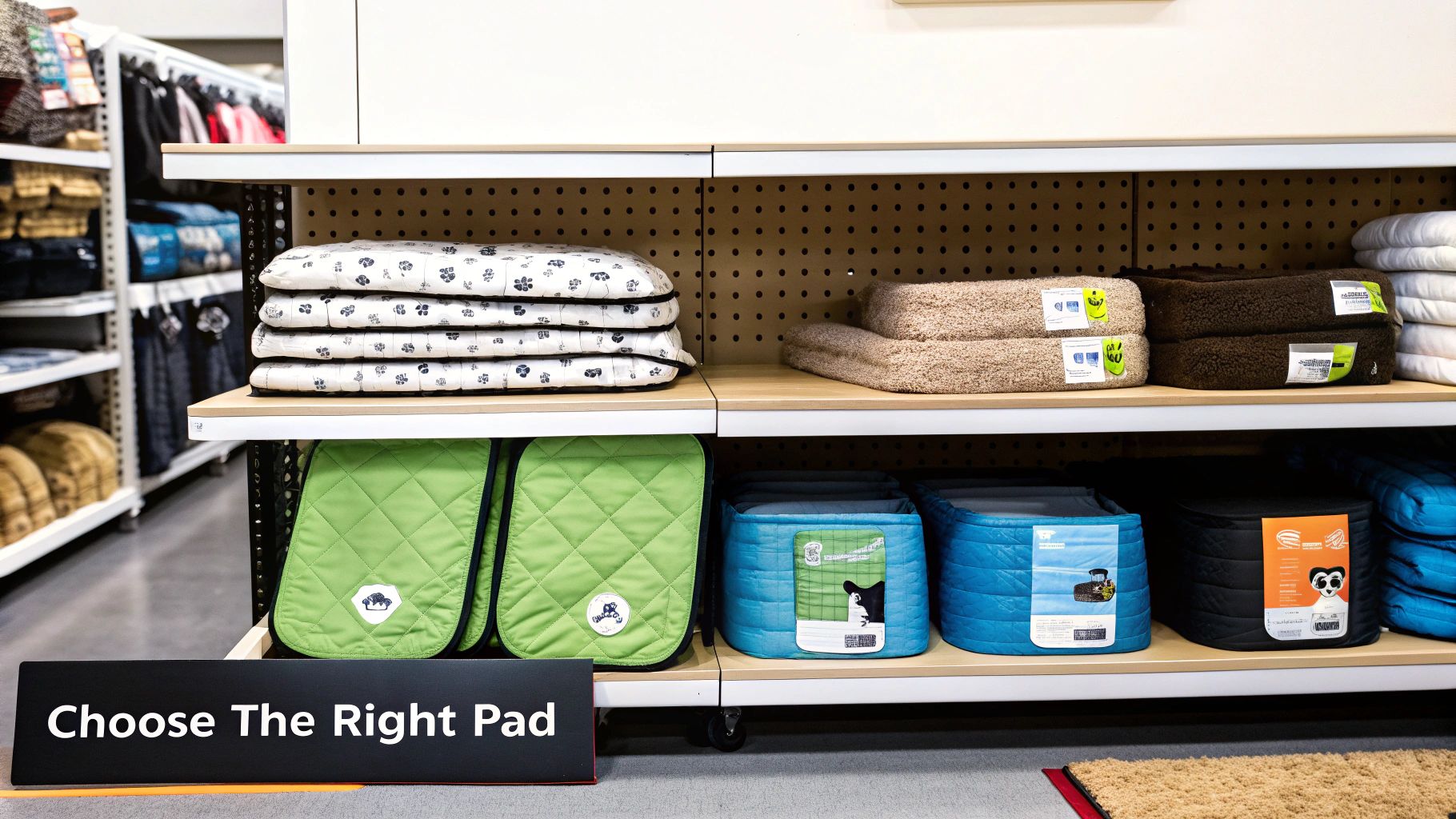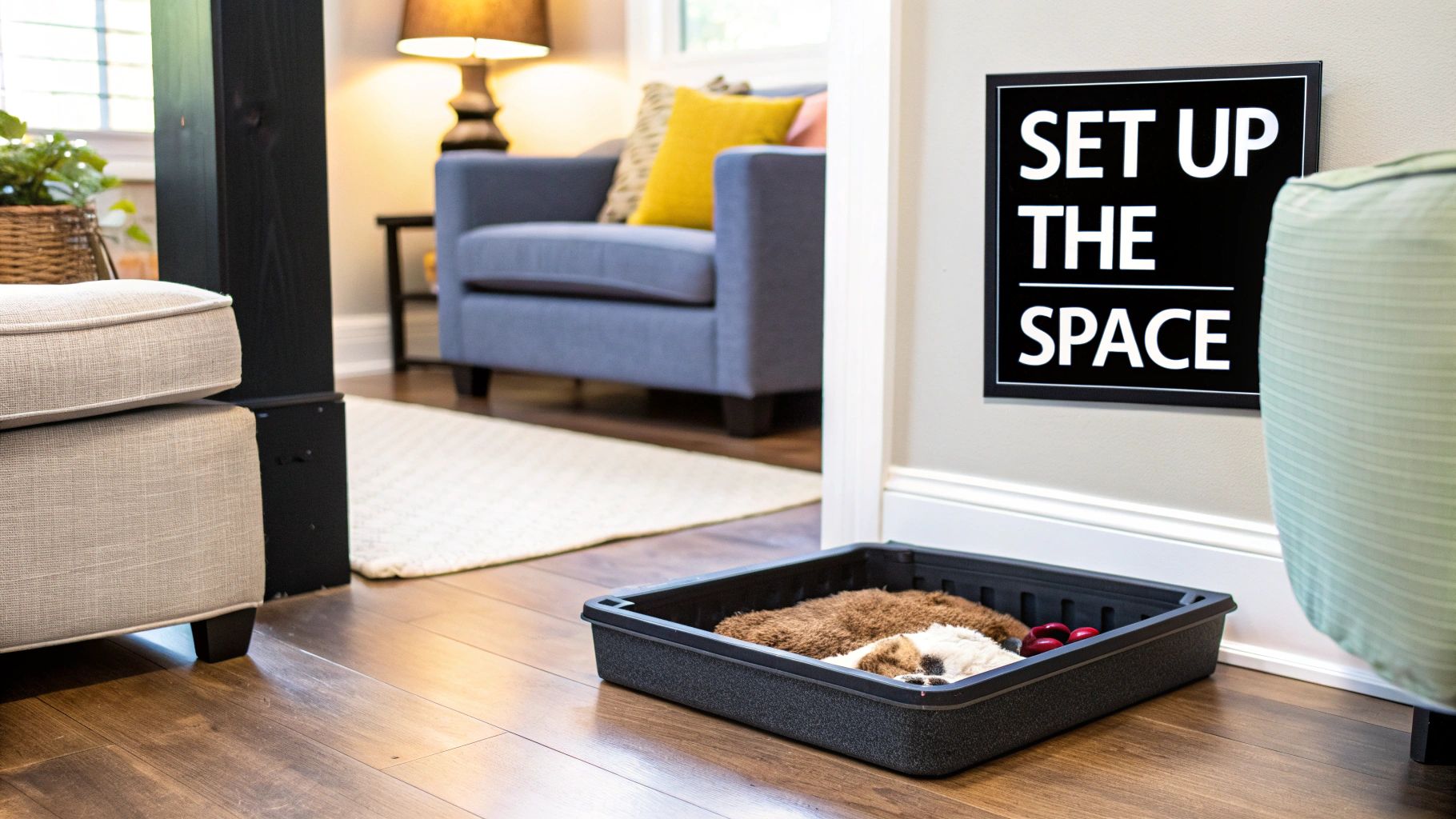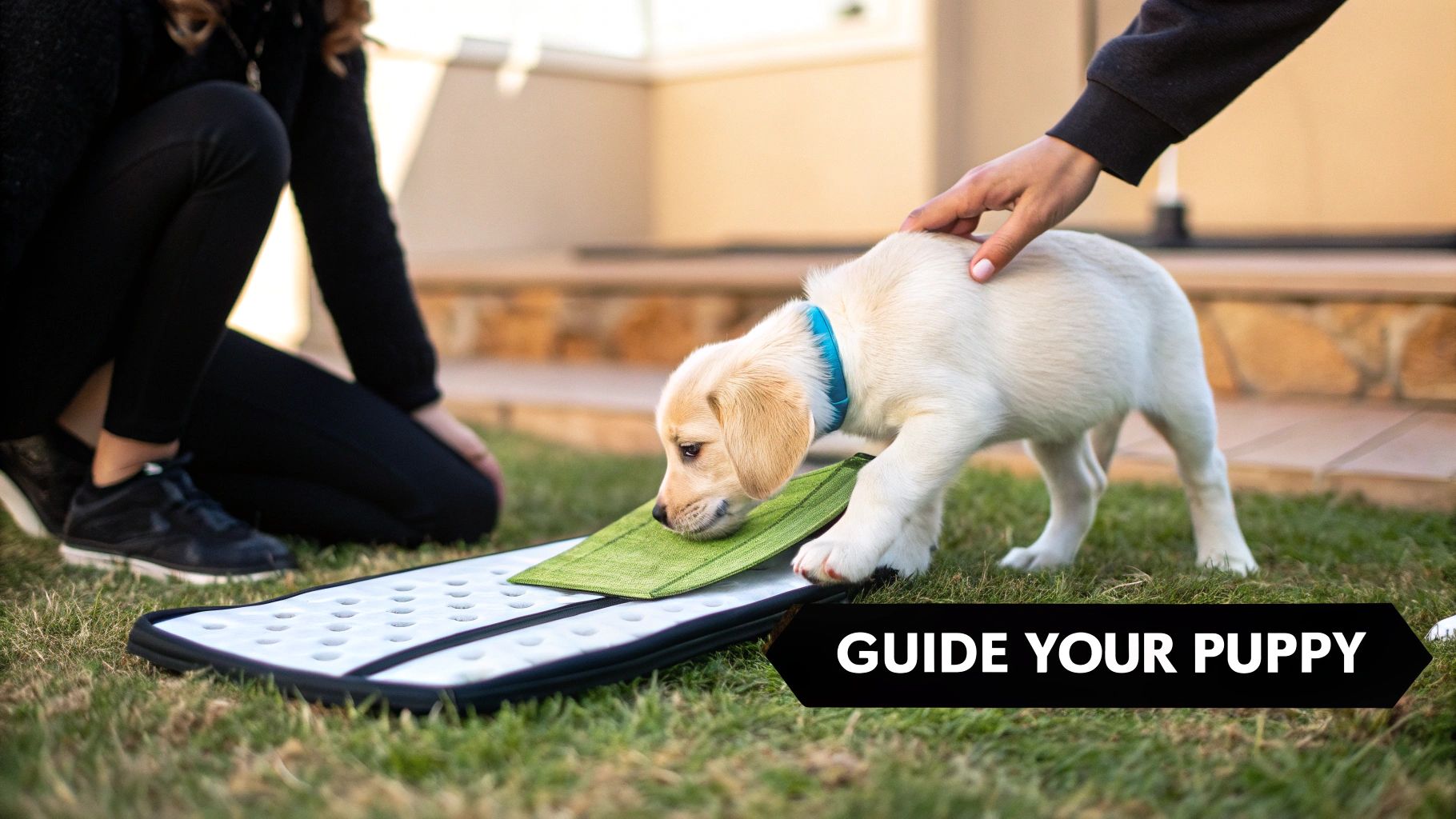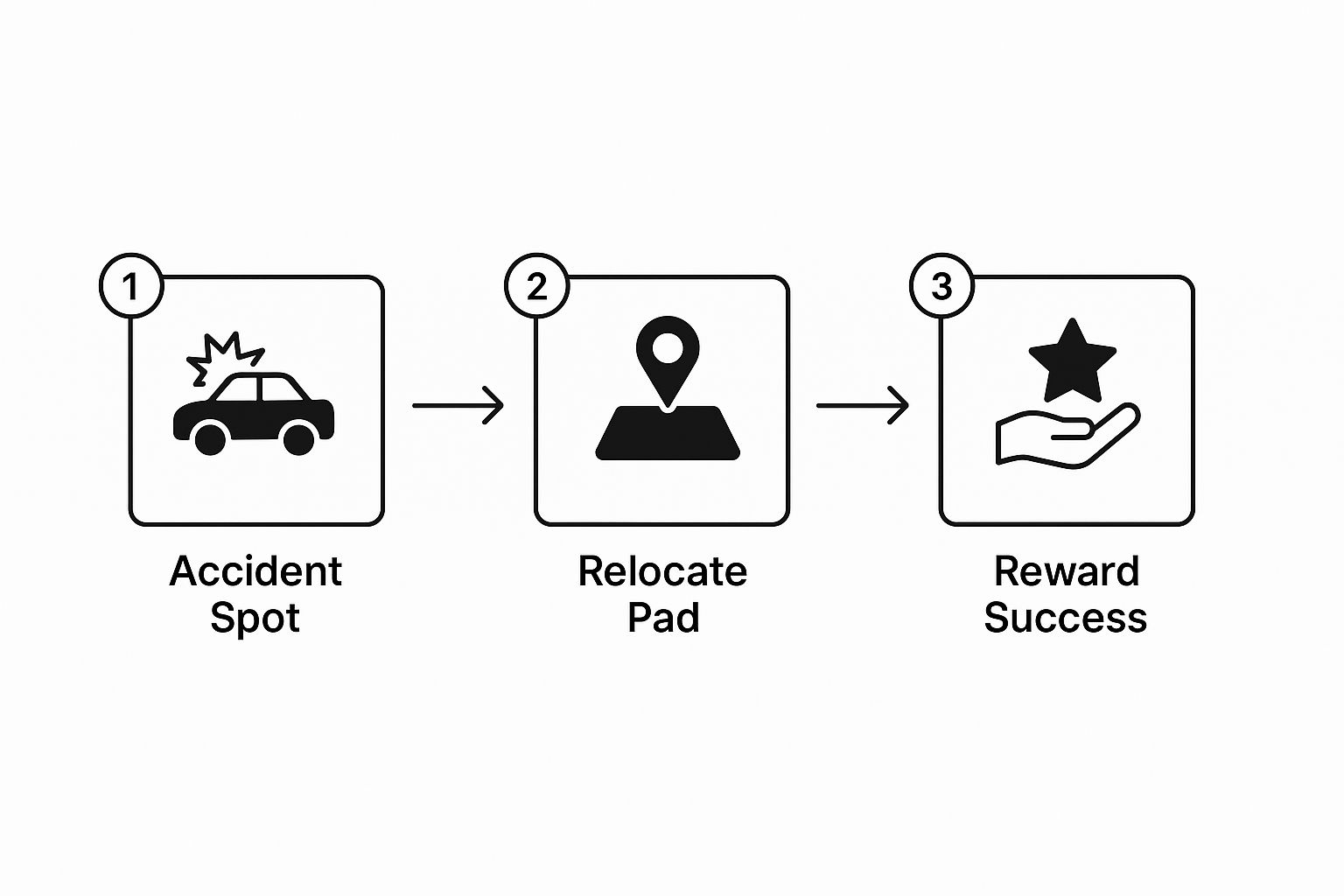Bringing a new puppy home is one of the most exciting, and let's be honest, chaotic times in your life. We get it. You're suddenly dealing with a whirlwind of fluffy energy, a brand-new personality, and yes, those inevitable little puddles on the floor.
That's where puppy pad training comes in. This isn't about finding a forever toilet solution indoors; it's about giving you and your pup a helping hand during those crucial first few weeks. Think of it as a lifesaver, especially if you live in a flat without a garden or you're just trying to get through the initial settling-in period with your sanity intact.
This process is all about creating a positive foundation together. It’s a straightforward method that boils down to three key things: strategic pad placement, a consistent routine, and bucketloads of positive reinforcement.
Why Pads Can Be Your Best Friend
Puppy pads give your new companion a clear, designated spot to relieve themselves. This helps protect your floors and starts building a routine right from day one. Let’s be clear though: accidents will happen, and that is perfectly okay.
Every single puppy learns at their own pace. Our goal here is to create an encouraging environment where your pup can learn and thrive without any fear or stress. This is a bonding experience, and we're going to build it on trust.
Remember, the goal of puppy pad training is not perfection, but progress. Celebrate the small wins, have compassion for the setbacks, and trust that you and your puppy will figure this out together.
Pads are particularly useful for:
- New puppies: Their bladders are tiny, and they need to go frequently—sometimes every hour!
- Apartment living: When a quick trip outside isn't always possible, an indoor spot is essential.
- Inclement weather: On rainy or freezing days, neither you nor your pup will want to venture out.
Before you dive in, it's a great idea to make sure you have everything you need. A little preparation goes a long way in making the first week as smooth as possible for both of you.
Your Puppy's First Week Checklist
| Essential Item | Why It's Important | Our Top Tip |
|---|---|---|
| High-Quality Puppy Pads | Absorbency is key to preventing leaks and protecting your floors. | Look for pads with a non-slip backing to keep them in place, even with a playful pup. |
| Enzymatic Cleaner | Standard cleaners won't eliminate the odour that attracts a pup back to the same spot. | Always have a bottle on hand for inevitable accidents. It's a game-changer. |
| High-Value Treats | You need something special to reward successful potty trips—something your pup really loves. | Small, soft treats work best. They're quick to eat and won't disrupt their main meals. |
| A Puppy Pen or Crate | This creates a safe, designated space and helps manage your pup when you can't supervise. | Make the space cosy with a comfy bed and a favourite toy to build a positive association. |
| Patience and a Good Mood | Your attitude sets the tone. A calm, positive approach makes training much less stressful for everyone. | Put on some music, take deep breaths, and remember this phase doesn't last forever! |
Having these items ready will help you start on the right foot and tackle any little challenges with confidence.
Setting Up a Solid Foundation
The UK market is full of products designed to help with puppy pad training. You'll find everything from super-absorbent pads with leak-proof edges to pad holders that stop your pup from shredding them. Their popularity shows just how many dog owners like you are looking for practical training solutions that fit modern life.
For many of us, pad training is a stepping stone. It often goes hand-in-hand with crate training, which is another fantastic tool for creating structure and security for your pup. If you're considering this, our guide on how to crate train a puppy offers a great deep dive to support you on your journey.
Choosing and Placing Puppy Pads for Success
Walk down any pet aisle and you'll quickly realise that not all puppy pads are created equal. Getting the right type of pad and, crucially, putting it in the right place can genuinely make or break your training journey. We’re here to help you get this part right from the start.
It's about more than just grabbing the first packet you see. You'll find a surprising variety of options, from disposables to reusables and even scented versions. This isn't just clever marketing; the growing demand for these products reflects a real need, particularly for those of us in UK cities where a garden isn't always a given.
In fact, the global market for puppy training pads is projected to nearly double by 2033. This boom is driven by owners like us who want convenient, hygienic solutions for our pets. You can dig into the numbers and trends in this detailed business report. This growth means you have more choice than ever, which is fantastic but can also feel a bit overwhelming. Let's break it down so you can find the perfect match for your pup and your home.
Finding the Right Pad for Your Pup
First things first, let's look at the main types of pads on offer. Each has its own benefits, and what works for a friend's dog might not be the best fit for yours. It’s all about what suits your lifestyle and your puppy.
- Disposable Pads: These are the most common choice for a reason. They're incredibly convenient—you just pick it up, bin it, and you're done. Look for options with high absorbency and a decent plastic lining to stop any leaks from reaching your floor.
- Reusable/Washable Pads: A brilliant eco-friendly and cost-effective alternative. These are made of fabric and can be popped straight into the washing machine. We've found they're often more durable and less tempting for puppies who have a penchant for shredding things.
- Scented vs Unscented: Some pads come with a built-in attractant scent designed to encourage your puppy to use them. While this sounds helpful, some pups are put off by the artificial smell. We generally recommend starting with unscented pads to avoid any potential confusion.
Your puppy's comfort is the top priority. If they seem hesitant about a particular type of pad, don't be afraid to switch it up. The goal is to make their designated spot feel safe and appealing.
Strategic Placement Is Everything
Once you’ve chosen your pads, where you put them is probably the most critical decision you'll make in this whole process. This isn’t about what’s most convenient for you; it's about understanding your puppy’s natural instincts.
A classic mistake we see time and again is placing the pad too close to their bed or food and water bowls. Dogs instinctively avoid soiling their sleeping and eating areas. Putting the pad there can create a huge amount of confusion and often leads to accidents elsewhere in your home.
Instead, choose a location that is:
- Accessible but Low-Traffic: Pick a quiet corner of a room where your family spends time, like the kitchen or living room. Your pup needs to feel safe and not be startled mid-potty.
- On a Hard Surface: If you can, start with the pad on a surface like tile or linoleum. This makes cleaning up any near-misses a whole lot easier.
- Consistent: Once you pick a spot, stick with it. Moving the pad around will only confuse your puppy and set your training progress back.
Building a Positive and Consistent Routine
When it comes to getting puppy pad training right, consistency is everything. But let’s be real – this doesn’t mean you need some stressful, minute-by-minute schedule. It’s about building a simple, effective routine that works with your puppy’s natural rhythm, not against it.
Think of yourself as a detective, learning to spot your puppy’s unique signals. The goal is to anticipate their needs before they even realise they have to go. This approach shifts training from a reactive guessing game into a proactive, positive experience that strengthens the bond you have.
This whole process is built on trust and positivity. We never, ever want to use punishment or create fear. Instead, every single success, no matter how small, becomes a reason to celebrate. This is exactly how your puppy learns that using the pad is a brilliant thing that makes you happy.
Timing Is Everything
Puppies have tiny bladders and very predictable potty triggers. Learning to recognise these key moments is your secret weapon. You’ll want to take your puppy straight to their pad immediately after these activities:
- Waking Up: The very first thing they should do after any nap.
- After Meals: Digestion gets things moving, so a trip to the pad about 5-15 minutes after they eat is a must.
- After Playtime: All that excitement and activity stimulates the bladder, making a post-play potty break absolutely crucial.
Keep an eye out for those classic tell-tale signs, too. Circling, sniffing the ground intently, or letting out a little whine are all signals. When you see these, it’s your cue to calmly and quickly lead them to their pad.
The Power of Positive Reinforcement
Positive reinforcement is the absolute heart of modern, effective dog training. It’s not about bribery; it’s about clearly communicating to your puppy, "Yes, that's exactly what I wanted you to do!"
The moment your puppy successfully uses their pad, it’s time to throw a mini-party. This instant celebration creates a powerful, positive association with the act itself.
Key Insight: The reward has to happen immediately—within a second or two—after they finish. If you wait any longer, your puppy won’t connect the treat with the action.
Combine these three things for the biggest impact:
- A High-Value Treat: Something small, delicious, and saved only for potty success. Think tiny bits of chicken or a special soft puppy treat.
- Enthusiastic Praise: Use a happy, excited tone of voice. "Good potty! Yes! What a clever puppy!"
- Affection: A happy scratch behind the ears or a gentle pat reinforces your praise wonderfully.
Introducing a Verbal Cue
As you get into the swing of this routine, you can start to introduce a simple verbal cue. Every time you take them to the pad and they begin to relieve themselves, say your chosen phrase, like "go potty" or "be clean," in a calm, encouraging voice.
Over time, your puppy will start to associate this phrase with the act of elimination. This becomes an incredibly useful tool, especially when you eventually transition to outdoor training. Understanding how to build these foundational behaviours is vital for any breed, and if you're raising a larger dog, our specific advice on Labrador Retriever puppy training might be especially helpful for channelling their energy. Remember, every step of this journey is about clear, kind communication between you two.
How to Handle Accidents with Empathy
Let's be completely honest: accidents are going to happen. No matter how perfect your routine is, there will be little puddles. And you know what? That is absolutely, one hundred percent okay. This is a normal, expected part of the puppy pad training journey.
The most important thing to remember is how you react in these moments. Your response really does set the tone for your relationship. Punishing or scolding your puppy for an accident isn't just ineffective, it can be genuinely damaging. It teaches them that you're unpredictable and scary, which erodes the very trust you're working so hard to build.
Instead of creating fear, we want to build understanding. Your puppy isn't having an accident to be naughty; they're having an accident because they're still learning. Our job is to be their patient, supportive teacher through it all.
What to Do When Accidents Happen
How you handle a mistake depends on whether you catch them in the act or discover it later. Both scenarios require a calm, empathetic approach. Remember, we're focused on positive solutions, not punishment.
If You Find an Accident Later
If you come across a puddle after the fact, there's only one thing to do: clean it up thoroughly and move on. Seriously, that's it. Never, ever rub your puppy’s nose in it or scold them. They simply won't connect your anger to the old accident; they'll just become confused and anxious.
If You Catch Them in the Act
This is your chance for a gentle teaching moment. Here’s a simple, effective technique we've used time and time again:
- Interrupt Gently: Make a sudden but not terrifying sound to get their attention, like a quick clap or a sharp "Ah-ah!" The goal isn't to scare them, but simply to interrupt the behaviour.
- Redirect Immediately: Scoop them up straight away and quickly move them to their puppy pad. Even if they don't finish their business there, you're reinforcing the correct location.
- Clean Up Properly: This step is absolutely critical. You must use an enzymatic cleaner to completely eliminate the urine odour. Standard household cleaners won't cut it, and any lingering scent will act like a magnet, telling your puppy, "This is a good potty spot!"
A Note on Potential Confusion
Interestingly, the use of puppy pads can sometimes be a point of debate among dog trainers in the UK. Some experts suggest that the soft texture of pads might inadvertently teach a puppy that any soft surface, like a rug or a pile of clothes, is fair game. This is why frequent outdoor trips and strong positive reinforcement for correct choices are so vital to your success.
The key takeaway is to remain calm and consistent. Every accident is just a data point showing you where you might need to adjust your routine, not a sign of failure. You've got this.
To minimise cleanup stress from accidents in other areas, you might also consider investing in washable and waterproof bedding. Having easily cleaned items, such as Memory Foam Pet Beds with Waterproof Liners, can significantly reduce your stress levels. It’s all about setting yourselves up for success.
Transitioning From Pads to Outside Toileting
This simple chart really captures the heart of what we're doing: notice where accidents happen, use that insight to place the pad well, and always celebrate a win. Once you understand this basic loop, you’re ready to take your puppy's training from the living room to the great outdoors.
For most of us, puppy pads were only ever a temporary fix—a stepping stone on the way to fully outdoor toileting. If you’re reading this, congratulations! It means you and your pup have already built a fantastic foundation of trust and routine. Now, let’s take that success outside together.
The secret to this transition is making it gradual. We're not going to just whip the pads away and hope for the best. That would only confuse your puppy and stress you out. Instead, we'll gently guide them toward their new, permanent potty spot.
The Great Migration Begins
First things first, start moving the puppy pad slowly towards the door you'll use for toilet breaks. Don't rush it. Just shift it a few feet every day or so. Your puppy is already conditioned to look for the pad, so we're just nudging its location in small, easy steps.
Your aim is to get the pad right next to the door. Once your puppy is consistently using it there, you've hit a major milestone. This creates a powerful link between the urge to "go" and being near the exit to the garden.
We’re essentially laying a trail of breadcrumbs for your puppy to follow. Each time they use the pad in its new spot, it’s a win. Keep the praise high and the treats coming to let them know they’re getting it spot on.
Once they're reliably using the pad by the door, you can take the next big step: place a fresh pad just outside the door in your designated garden spot.
Aligning Indoor Routines With Outdoor Goals
Now it's time to merge your established indoor schedule with an outdoor one. Stick to the same timing you’ve perfected—take them out first thing in the morning, after meals, and after a good play session. But instead of leading them to the indoor pad, you'll take them straight outside to the pad in the garden.
Use the exact same verbal cue you’ve been practising, like "go potty." The familiar sight of the pad, the sound of your cue, and your encouraging presence will give them the confidence to do their business in this new place. The moment they succeed, celebrate! Make an even bigger fuss than you did for indoor successes. This is a huge achievement for you both.
- Be Patient with Setbacks: Your puppy might hesitate or have an accident inside. It’s okay. Just take a step back, maybe by putting a pad inside by the door again for a day, before trying again.
- Strengthen Their Recall: As you spend more time in the garden, a solid recall becomes vital for safety. For more tips, our guide on how to train dog recall offers clear, practical steps.
- Fade the Pad: Once they're consistently going on the pad outside, you can make it smaller or eventually remove it completely. By then, the habit of going in that specific spot will be firmly established.
This is the final chapter of your puppy pad training. You're setting your dog up for a lifetime of clean habits and successful toilet breaks. Take a moment to appreciate how far you've both come. You did it!
Got Puppy Pad Problems? We’ve Got Answers
Let's be honest. Even the most perfect puppy pad training plan can hit a snag. You might be doing everything right, but your little one still seems to be making up their own rules. It's totally normal to feel a bit stuck when this happens.
Don't worry, you’re not the first person to face these little hiccups. Let’s walk through some of the most common questions we get from new puppy owners and find some real, practical solutions to get you back on track.
Why Is My Puppy Shredding the Pads?
Ah, the classic pad-shredding problem. We hear this one all the time! If your puppy seems determined to turn their potty pad into a snowstorm of fluff, it’s almost always down to one of two things: boredom or sheer puppy playfulness. To a pup with a curious mind, that crinkly, soft pad can look like the best toy they’ve ever seen.
The first step is to make sure they have better things to do. A good puzzle feeder or a tough chew toy can be a game-changer for a bored puppy. If the confetti-making continues, try a puppy pad holder. It’s a simple plastic frame that snaps the pad into place, making it much tougher for your little whirlwind to get a grip and start ripping.
Help! My Puppy Sleeps on the Pad Instead of Using It
It’s a common mix-up, and it makes perfect sense from a puppy’s point of view. They naturally seek out soft spots for a nap, and if the pad is the cosiest thing in their pen, it might as well be a bed! This is exactly why we stress the importance of keeping their sleeping and potty areas completely separate.
Make sure their actual bed is far more comfortable and inviting than the pad. If the napping continues, simply move the pad further away from their crate or sleeping spot. This physical distance helps them build the mental association that one area is for rest, and the other is strictly for business.
Remember, your puppy isn't being stubborn or naughty on purpose. They're just a baby learning to navigate a very human world. Your patience is the key that helps them figure it all out.
What if My Puppy Keeps Missing the Pad?
So close, yet so far! This is one of the most frustrating parts of the process. When your puppy consistently goes right next to the pad but not on it, it’s usually just a simple aiming issue or a tiny misunderstanding of the target zone.
Here are a few things that can really help:
- Go bigger: Try using a larger pad for a while. A bigger target is harder to miss!
- Double up: Place a second pad right next to the first one. This temporarily doubles the size of the acceptable potty area.
- Reward the 'almost': If you catch them going just off the edge, don't scold them. Praise them gently for getting close – they were in the right neighbourhood! Then, make sure to clean the miss with a good enzymatic cleaner.
Every single step in the right direction is a win, no matter how small. Your encouragement will help them make that final connection. You and your pup are a team, so stick with it – you'll get there together.
At My Life My Dog, we're passionate about giving owners the information they need to build a brilliant life with their dogs. For more in-depth guides on everything from training to health, visit us at https://mylifemydog.com and continue your journey with confidence.









